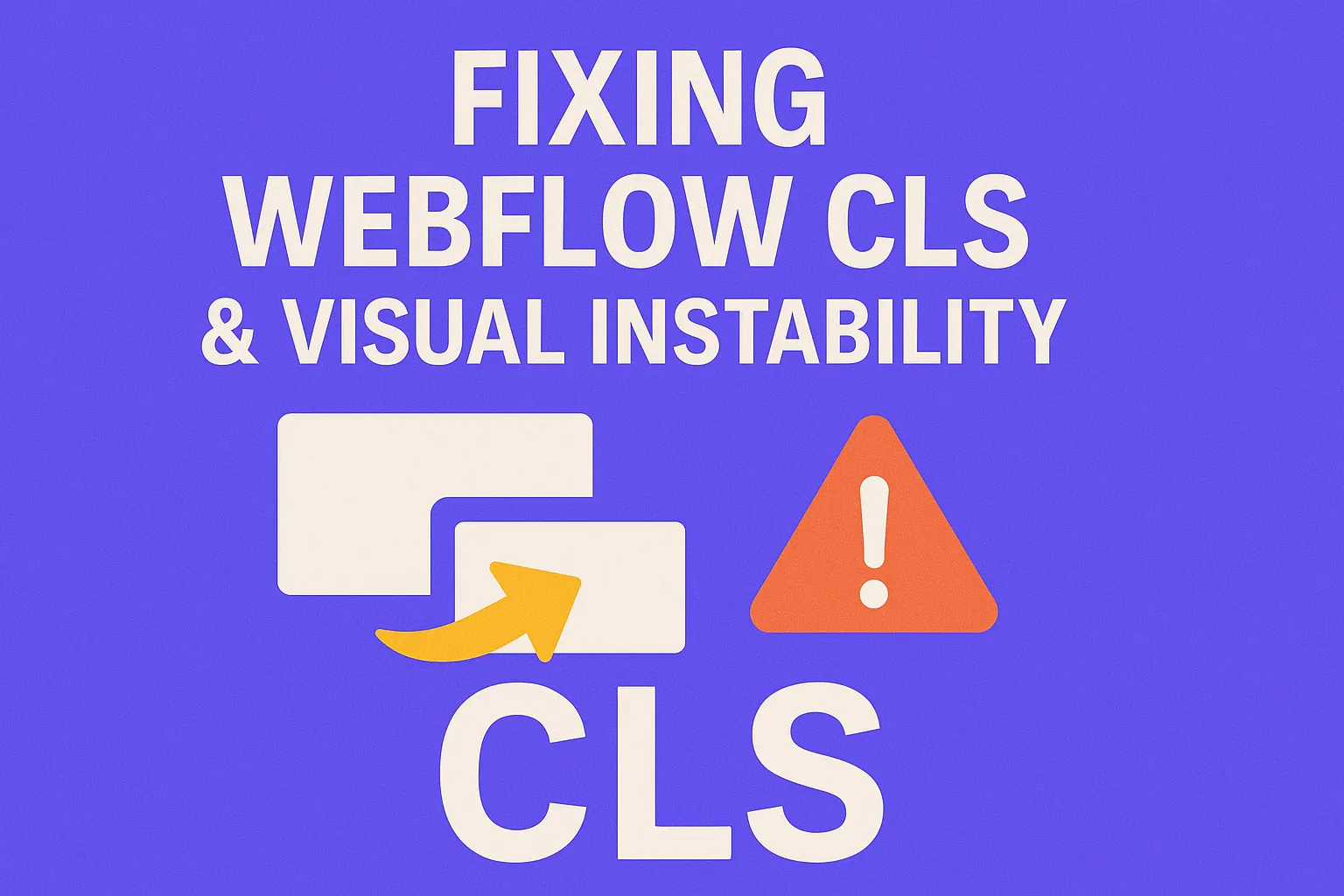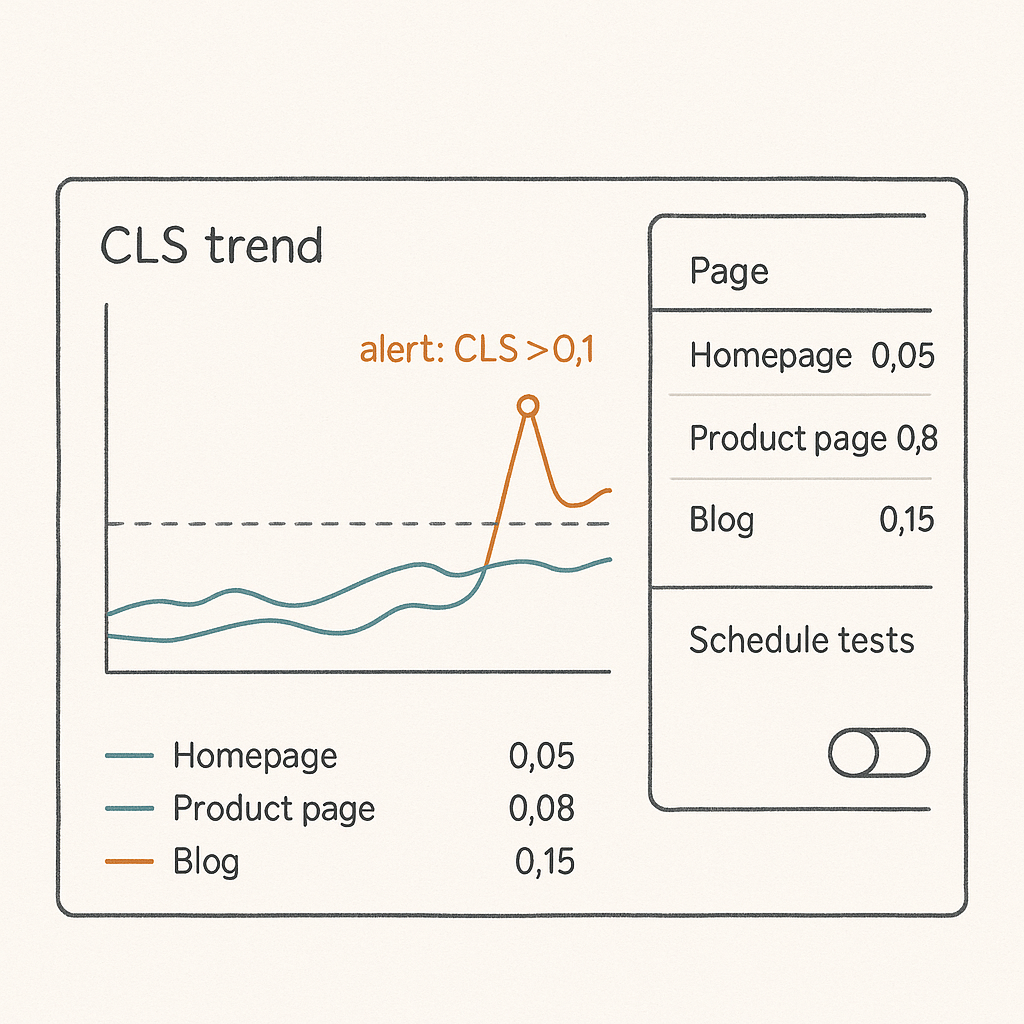Fixing Webflow CLS and Visual Instability
Written by
Andy Dao
,CEO
Published on:
August 18, 2025

What is Cumulative Layout Shift (CLS) and Why It Kills Your UX
Ever loaded a Webflow site, started to click a button—and the whole layout shifted at the last second? You’re not alone. Cumulative Layout Shift (CLS) is the technical term for those annoying visual jumps. They hurt your user experience, frustrate visitors, and cost you conversions.

Example of a visible layout shift: hero asset loading pushes content and hurts UX/CTR.
CLS is now a top-ranking factor in Google’s Core Web Vitals. According to Google’s 2024 Web Vitals study, sites in the top 10% for CLS scored 18% higher on average in organic click-through rates—and eCommerce brands with poor CLS lost up to 15% of conversions versus “stable” competitors (source: web.dev/vitals).
If you run your SaaS or marketing site on Webflow, there’s good news and bad news:
- Bad: Webflow is not immune to layout shifts. Image loading, custom fonts, and third-party embeds often break visual stability out of the box.
- Good: You can fix CLS in Webflow fast—if you know what to audit and tweak.
- Find your real CLS problem areas in Webflow
- Fix image, video, font, and embed issues—step by step
- Apply Webflow-specific code and best practices for 2025 and beyond
- Benchmark, test, and monitor for lasting Core Web Vitals gains
Ready to reduce Webflow visual instability, boost your search rankings, and win back every lost click? Let’s break down Webflow layout shift troubleshooting from audit to action.
Understanding CLS in Webflow
Cumulative Layout Shift (CLS) measures how much visible elements unexpectedly move as your page loads. Webflow sites—especially with lots of images, embeds, and dynamic content—are vulnerable to layout instability out of the box.
Common CLS Triggers in Webflow
- Unconstrained images/videos. Missing width/height attributes.
- Delayed font rendering. Web fonts causing "flash of invisible text" (FOIT) or "flash of unstyled text" (FOUT).
- Third-party embeds. YouTube, forms, calendars, chat widgets loading unpredictably.
- Lazy-loading or unoptimized asset loads. Out-of-order resources shifting elements downward.
CLS is measured as a score between 0 (no shift) and 1+ (extreme shift). A “good” CLS score is 0.1 or lower.
- Tracks instability in visible elements as the page loads
- Penalizes unexpected layout moves (elements shifting not caused by user interaction)
- CLS = Largest burst of all visible shifts during a page lifespan

Visual breakdown: how layout shifts over time contribute to a page's CLS score.
Webflow-Specific Examples:
- Hero image loads after text above the fold, pushing down your headline
- Custom font flashes late, resizing paragraphs already on-screen
- YouTube/Vimeo blocks pop in, booting other content downward
Visual instability = bad UX, lost trust, and weaker conversion.
Step 1: Identify and Measure Your Webflow CLS Score
You can’t fix what you can’t measure. For every Webflow site, you need to run a CLS and Core Web Vitals audit using real-world tools.
The Best CLS Audit Tools for Webflow
- Google PageSpeed Insights (pagespeed.web.dev): Shows lab and field CLS scores with actionable recommendations.
- Lighthouse (Chrome DevTools tab): In-browser report for layout shift sources, step-by-step.
- Webflow Audit panel: Native Webflow Designer panel for performance and accessibility flags.
- Web Vitals browser extension: Live visual alerts for CLS events as you browse your own site.
- Current CLS score (target: ≤ 0.1 for every template/page)
- Largest Contentful Paint (LCP)
- Elements with late/unstable loads (images, typographic shifts, embeds)
Case Study: Example Webflow CLS Audit
Let’s say your page gets a CLS score of 0.32 on Google PageSpeed Insights. The breakdown points to:
- Hero video loads last, shifts content down (187 ms event, 65% shift)
- Footer widget jumps in after above-the-fold loads (92 ms event, 23% shift)
- Custom font loads after heading, resizing body text (58 ms shift, 12%)
Document every problem area on both mobile and desktop. Screenshot/lab-report every element that shifts.
| Tool | Why Use It | Key Metric |
|---|---|---|
| PageSpeed Insights | Field & lab CLS score, critical element listing | CLS value + "Avoid large layout shifts" flag |
| Lighthouse (DevTools) | Real-time shift highlighting, audit trace | Layout Shift Elements (step-by-step) |
| Webflow Audit | Quick performance flags, in-Designer view | Assets missing width/height, slow font loads |
| Web Vitals Extension | Instant CLS alerts on live Webflow sites | Live shift overlays while browsing |
Pro tip: Triage your pages. Fix worst-offenders first—usually your homepage, key conversion or product landing pages, and high-traffic blog posts.
Step 2: Fixing Image and Video-Related CLS in Webflow
Images and videos are the top culprits of Webflow layout shifting issues. If your visuals don’t declare space for themselves before loading, everything on the page will jump to make room.
Set Explicit width and height Attributes
- In Webflow Designer, select every image block
- Set
widthandheightexplicitly (never just use “auto”) - This reserves the right-sized box before the asset loads, preventing layout shifts
width="120" height="40" (numbers match native pixel dimensions).
Use Responsive Image Practices
- Upload images at multiple device-optimized sizes (Webflow creates these if you use the Image block)
- Check srcset and sizes generated for
<img>tags - Ensure breakpoints aren’t cropping or stretching images unexpectedly
Smart Lazy Loading in Webflow
- Use Webflow’s native lazy loading (
loading="lazy"on images/videos)—but only below the fold - Never lazy load assets that appear immediately in the viewport, or you’ll create a visible jump as they appear
- For videos, use static poster images to reserve space until the media loads (YouTube embeds can be swapped for images with Play buttons)
width/height), and be lazy-loaded only below the fold.
Media Embeds: Avoiding CLS with YouTube, Vimeo, and More
- Wrap all embeds in a fixed-aspect-ratio div (e.g., 16:9)
- Set the wrapper to
position: relative;and use padding-bottom hack for aspect ratio (see: CSS Tricks tutorial) - Set min-height to match video placeholder so layout never collapses
- With dynamic content, set fallback placeholder images for slow connections
| Problem | Old Way | CLS-Proof Fix |
|---|---|---|
| Hero image loads late | No dimensions, lazy loaded | width/height set, eager load |
| YouTube embed pops in | Unconstrained iframe | Aspect ratio box, min-height set |
| Team photos resize on mobile | Auto or % width only | Set width/height, use srcset |
Step 3: Font and Webflow Asset Best Practices to Prevent CLS
Fonts are silent CLS killers. If your Webflow site loads custom web fonts, you risk FOUT (flash of unstyled text) or FOIT (flash of invisible text)—text jumps that resize your layout after initial render.
Avoid FOIT and FOUT with font-display: swap
- Set all imported web fonts to
font-display: swapin your Project Settings → Custom Code → Head section - This tells browsers to use fallback system fonts until your custom font is ready (prevents invisible or resizing text jumps)
- Example:
<link rel="stylesheet" href="https://fonts.googleapis.com/css?family=Roboto:400,700&display=swap">
Host Fonts Locally or via CDN (Not Third-Party .ttf URLs)
- Let Webflow host fonts directly, or use an enterprise CDN
- Avoid slow font/CDN providers that delay loads by >200ms
- Check Waterfall tab in Chrome DevTools → Network for font load times
Preload Common Font Assets
- Use
<link rel="preload" as="font" href="..." crossorigin>in your Custom Code - Prioritize your most frequently used weights and styles (e.g., 400, 700)
- This removes the gap between normal and bold font rendering, shrinking the “pop”
Sample Code: Font Swap Without FOUT
<link rel="preload" as="font" href="/fonts/Roboto-Regular.woff2" type="font/woff2" crossorigin>
<link href="https://fonts.googleapis.com/css?family=Roboto:400,700&display=swap" rel="stylesheet">This guarantees instant fallback font, seamless swap to your brand font—and zero layout jump.
Step 4: Embeds, Forms, and Third-Party Widgets
Embeds and widgets (think Calendly, live chat, socials, and forms) are notorious for triggering layout shifts. Many load out-of-order, and with unpredictable heights.
Reserve Space for Embeds and Iframes
- Wrap every embed in a sized div with fixed height (for non-responsive elements) or an aspect-ratio container (for video and map embeds)
- Set min-height to match the embed’s typical rendered height
- Avoid 0-height elements that expand after remote JavaScript or styles load
Defer Non-Critical Widgets
- Set third-party scripts to
deferorasyncif possible - For chat pop-ups or NPS widgets, only load after user interaction or a scroll event
- Add “Load more” or “Show chat” buttons to trigger non-critical widgets offscreen
Webflow Forms: Fixing CLS from Live Validations and Confirmation Messages
- Set fixed min-heights for the container block where error/success messages appear
- Pre-allocate space for messages (avoid pushing down content on submit/validation)
- Test on mobile: input elements with built-in browser autofill can cause shifts if not sized right
Widget Block Settings in Webflow Designer
For each custom code or embed block:
- Set Display to
blockorflexfor predictability - Set min/max widths to avoid expanding past the intended layout
- Use built-in aspect-ratio on containers for maps/videos
Step 5: Testing, Monitoring, and Iterating
Fixing CLS is not a one-off—a stable Webflow UI requires ongoing checks and iterative improvements, especially after launches or edits.
Best Tools for Recurring Webflow CLS Testing
- Webflow Editor: Use staging to spot new layout shifts after team changes
- Chrome DevTools
Performancetab: Visualize layout shift events for every page render - Web Vitals Browser Extension: Live CLS score & box overlays for instant checks
- PageSpeed Insights and Lighthouse: Schedule weekly tests, export and compare results
User Session Recordings: Find Invisible Instability
- Solutions like Hotjar record user sessions and highlight visual instability
- Replay sessions to spot jumps not picked up by automated lab tools (real-world device variance, slow network, etc.)
- Tag and log every notable shift as a fix-it ticket
Set Up Automated CLS Alerts
- Platforms like Calibre, DebugBear, or Treo.sh provide daily/weekly Core Web Vitals tracking for Webflow
- Configure alert thresholds (e.g., notify if CLS rises above 0.1 on any template)
- Benchmark regularly against pre/post-launch, Core Web Vitals update cycles, and page changes

Example monitoring dashboard: track CLS per page, set alerts, and spot regressions quickly.
Advanced Tips: Webflow-Specific Code Snippets and Hacks
When built-in fixes aren’t enough, use these low-code hacks to prevent CLS in Webflow projects.
Conditional CSS to Prevent Layout Shifts
/* Set min-height for dynamic content */
.my-form__confirmation {
min-height: 48px;
transition: min-height 0.2s cubic-bezier(.4,0,.2,1);
}
JavaScript Fix: Enforce Image Aspect Ratios
<script>
document.querySelectorAll('img').forEach(function(img) {
img.style.aspectRatio = (img.naturalWidth / img.naturalHeight).toFixed(2);
});
</script>
Apply to CMS-driven galleries or user-uploaded images for consistent container sizing.
Resource Loading Optimization
- Preconnect to font providers/CDN:
<link rel="preconnect" href="https://fonts.googleapis.com">
<link rel="preconnect" href="https://fonts.gstatic.com" crossorigin>
These help browsers fetch font assets earlier, shrinking the risk window for late shifts.
Actionable Takeaways and Conclusion
Your Webflow CLS Audit & Fixes Checklist:
- Run PageSpeed Insights/Lighthouse on all main pages—fix high-CLS offenders first
- Add
width/heightto every image, video, and major block element - Wrap video and embed blocks in fixed/aspect-ratio containers
- Set all web fonts to
font-display: swapand preload/host locally via Webflow - Give all forms and widgets fixed min-heights to avoid shifting on interaction
- Test, monitor, and set up real-time performance alerts
A site that never jumps is trusted by users and Google—resulting in higher rankings, better engagement, and more conversions.
Don’t let hidden layout shifts cost your SaaS brand reputation or revenue. Audit, implement, and automate your way to a rock-solid, stable Webflow experience.
For more detailed platform guidance (including upcoming Webflow performance releases), check the latest at web.dev/vitals and Webflow's official Core Web Vitals optimization resources.
Unlimited Design & Webflow Development
Get unlimited design & development requests for a flat monthly rate. Fast turnaround without compromising on quality. No contracts or surprises. Cancel anytime.



